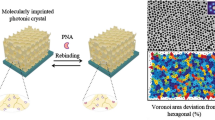Abstract
Silica particles containing immobilised peptidic templates have been used for the generation of hierarchically imprinted polymers. The pores of the silica mould were filled with a mixture of monomers/initiator and polymerised, followed by dissolution of the silica template. This method leaves behind imprinted polymers with binding sites located at the surface, which are capable of recognising larger molecules with the same immobilised epitope. All the products resulting from solid-phase synthesis of peptides were characterised by elemental analysis, FT-IR spectroscopy and fluorescence microscopy. The hierarchically imprinted polymers generated from these products were characterised by elemental analysis, FT-IR spectroscopy, fluorescence microscopy, scanning electron microscopy (SEM) and nitrogen adsorption, providing evidence concerning the reproducibility of each step. The chromatographic properties of the materials have been investigated and the advantages of the immobilisation method have been proven. The materials exhibit selectivity for their templates and other structurally related dipeptides. Furthermore, the polymers proved to be capable of recognising larger peptides containing the immobilised sequence.









Similar content being viewed by others
References
Sellergren B (ed) (2001) Molecularly imprinted polymers. Man made mimics of antibodies and their applications in analytical chemistry. Elsevier, Amsterdam, vol 23; Wulff G (2002) Chem Rev 102(1):1
Perez N, Whitcombe MJ, Vulfson EN (2001) Macromolecules 34:30
Matsui J, Okada M, Tsuruoka M, Takeutchi T (1997) Anal Commun 34:85
Ye L, Cormack P, Mosbach K (1999) Anal Com 36:35; Tamayo FG, Casillas JL, Martin- Esteban A (2003) Anal Chim Acta 482(2):165
Sulitzky C, Rücket B, Hall AJ, Lanza F, Unger KK, Sellergren B (2002) Macromolecules 35(1):79; Sellergren B, Rückert B, Hall AJ (2002) Adv Mat14:1204
Dai S, Burleight MC, Ju YH, Gao HJ, Lin JS, Pennycook SJ, Barnes CE, Xue ZL (2000) J Am Chem Soc 122:992
Yilmaz E, Haupt K, Mosbach K (2000) Angew Chem Int Ed 39(12):2115
Sellergren B, Büchel G (1999) WO01/32760 A1
Titirici MM, Hall AJ, Sellergren B (2002) Chem Mater 14:21
Venton DL, Gudipati E (1996) Biochim Biophys Res Commun 227:419
Hjerten S, Liao J-L, Nakazato K, Wang Y, Zamaratskaia G, Zhang H-Y (1997) Chromatographia 44:227
Hirayama K, Burow M, Morikawa Y, Minoura N (1998) Chem Lett 731
Titirici MM, Hall AJ, Sellergren B (2003) Chem Mater 15:822
Carlier E, Guyot A, Revillon A (1991) React Polym 16:115
Vansant EF, Van Der Voort P, Vrancken KC (1995) Characterisation and chemical modification of the silica surface. Elsevier, Amsterdam, vol 93
Sherrington DC, Hodge P (1998) Synthesis and separation using functional polymers. Wiley, Chichester
Kaiser E, Picart F, Kubiak T, Tam JP, Merrifield RB (1993) J Org Chem 58:5167
Sellergren B, Shea KJ (1993) J Chromatogr 635:31
Gagne MR, Becker JJ, Brunkan NM (2000) Polym Prep 41:404
Rachckov A, Minoura N (2001) Biochem Biophys Acta 1544:255
Acknowledgements
We thank Gunnar Glasser (MPI für Polymerforschung, Mainz) for recording of the SEM micrographs. Financial contribution from the Deutsche Forschungsgemeinschaft (DFG) under Project 777/5–1 is gratefully acknowledged.
Author information
Authors and Affiliations
Corresponding author
Rights and permissions
About this article
Cite this article
Titirici, M.M., Sellergren, B. Peptide recognition via hierarchical imprinting. Anal Bioanal Chem 378, 1913–1921 (2004). https://doi.org/10.1007/s00216-003-2445-5
Received:
Revised:
Accepted:
Published:
Issue Date:
DOI: https://doi.org/10.1007/s00216-003-2445-5




